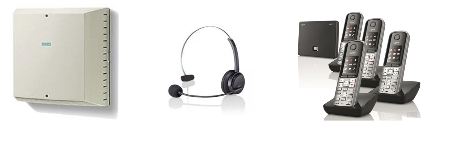Telephone Systems
Concepts of modern telecoms
The most important interface you may have with your existing and future clients is via the telephone and the phone system you choose is critical to your business and should take into consideration future expansion and services.
Customers expect a minimum standard of communications and in todays world expect to be able to get hold the person they are calling or at least be able to leave a message.
It is vital these calls are handled correctly, in the past such services as voicemail or call diversion were sold as an additional cost and as an add on however, with modern technology, these features and beneifts are now standard in all applications on an entry level.
How about call recording for "training & quality" purposes. Another cost effective tool in the new armoury of the telecommunications arena.
About Phone systems
Simple extensions
You can have more than one phone on a single-number line. All extensions ring when an incoming call arrives; any extension can make an outgoing call, but that prevents anyone else from doing so.
Essentially we are talking about the same kind of setup you have at home. For a very small company this can be an economical, starting point– particularly with everyone working in a single office, so that you can see or hear whether anyone is using the line.
Key systems
These typically have multiple buttons on each phone, originally they where clickable keys, for selecting one of several outside lines or for calling an internal extension. Installation is often very simple; most systems plug directly into regular phone jacks, without any need for separate wiring.
PBX
Key systems above are generally aimed at 8-20 users while PBXs - private branch exchanges - handle larger workloads. Essentially the PBX is a smaller version of the switching equipment used by the phone company to direct calls at its telephone exchanges. And while all the control electronics for a modern key system may well be embedded in the phones themselves a PBX will almost certainly need a separate controller cabinet. Typically the user has to dial 9 to get an outside line.
Inside that is what amounts to a whole computer, programmed to provide advanced phone functions. PBXs usually have an operator or switchboard to monitor and route incoming calls to the extension requested. That provides a human face for the system, and the importance of this should not be understated although automated systems work for smaller offices. PBX stands for Private Branch Exchange,which is a private telephone network used by a company.
In technical terms, modern PBXs do not need human intervention - with facilities like:
- Auto attendant - this directs the incoming call to the appropriate destination by asking the caller to select particular options
- Voicemail - records messages for people who are away from their desk
- DDI - which allows a caller to dial a specific number that gets them directly to a particular extension.
The right mix
Even a simple key system these days comes with a full selection of features and facilities. They will not all be useful to all users. So instead of comparing features on a one-to-one basis, you should think about how you will actually use a phone system; look at the features that will improve workflow in the office.
And although it is important to have the right features, ease of use is even more critical. People should not have to devote too much time to learning the phone system: the key functions, and especially those used most frequently, must be extremely simple and intuitive.
These are some of the common considerations:
- Call barring - prohibits specified types of call (overseas calls, for instance, or to 0898 numbers)
- Automatic Route Selection - can automatically select the cheapest network for each call.
- Multi-site communications - all incoming calls go through a single central number but are redirected to the relevant site, or perhaps to a mobile phone if you're out of the office.
- Auto attendant - automatically answers the call with a customised message that prompts customers to route their calls to the appropriate destination.
- Voice mail - allows the caller to leave a recorded message.
- Message notification - alerts the user that their voicemail box contains unread messages (with an indicator light on the phone, or perhaps by automatically calling a pre-programmed contact number
For further information please contact our sales team.
Any queries or concerns?
Please call us on 01993841406 or use our contact form.
We are located at:
KOG Systems Ltd
Oaks Meade
Carterton
OX18 1JX
Contact us today!
If you have any queries or wish to make an appointment, please contact us:
01993 841406
0845 2413060
info@kogsystems.co.uk
Or use our contact form.



